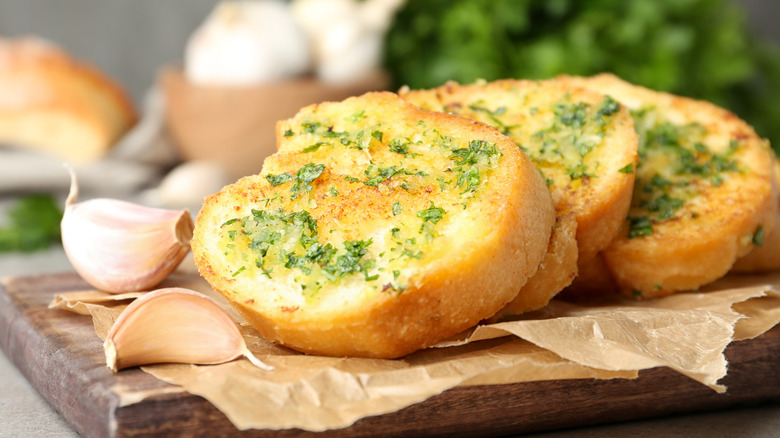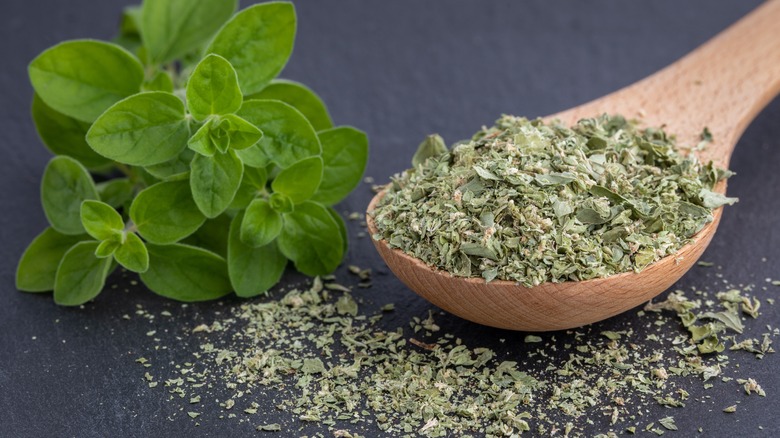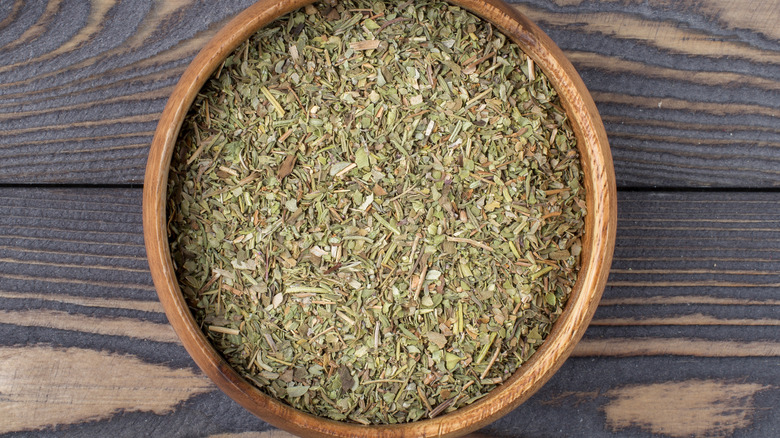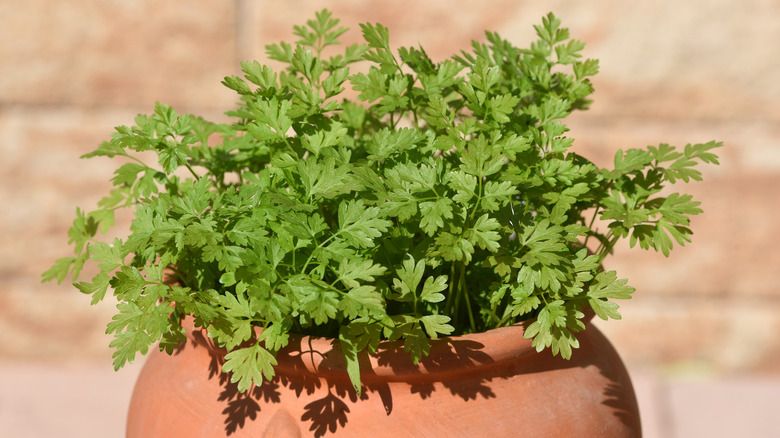The Best Herbs To Elevate Your Garlic Bread
There's nothing quite like dragging a piece of buttery garlic bread through a pool of marinara sauce as an appetizer or crunching into a slice alongside a hearty bowl of spaghetti. The combination of butter, garlic, and cheese creates a strong umami flavor profile that pairs well with just about any kind of soup, stew, or pasta dish — but one ingredient is often overlooked when making the soft yet crunchy side: herbs. Not only do they add a dash of green to an otherwise muted color palette, but the right herbs can help upgrade this toasted snack by imparting subtle fresh and, well, herbaceous flavor notes.
Parsley is perhaps the obvious choice when it's time to sprinkle some chopped herbs on garlic bread. It's likely what your favorite Italian restaurant uses, and the herb celebrity chefs like Rachael Ray and Ina Garten turn to. (Yes, even in her uniquely Ina way, Garten still opts for parsley.) Some home cooks, like blogger A Spicy Perspective, also choose herbs like thyme, rosemary, or basil to adorn their garlic bread, and while there's certainly nothing wrong with using such herbs (they all pair quite well with the baked buttery and garlicky flavors), there are a few other substitutions we've come across that give old-school parsley a run for its money.
Oregano
Our first pick is oregano, which MasterClass explains can add a robust, earthy flavor to your garlic bread that is both sweet and a little spicy. Rich in antioxidants and Omega-3s, the herb is popular in southern Italian cooking, per Cucina Toscana, so if you're a fan of Italian food you're likely familiar with the flavor. If you have dried oregano on hand, two teaspoons should be a sufficient amount to sprinkle on top of your sliced garlic bread before baking, according to The Seattle Times, or you can opt for fresh. As dried herbs are more concentrated than fresh ones, Martha Stewart suggests swapping them at a ratio of one teaspoon dried to one tablespoon fresh.
There are several different types of oregano — such as Greek, Italian, Cuban, and Mexican — which all have a similar flavor profile with slight variations. Greek oregano is one of the more popular varieties as well as its Italian counterpart, which is actually a cross between sweet marjoram and Greek oregano (via Home Stratosphere).
Herbs de Provence
Another amazing garlic bread option is herbs de Provence, which is a combination of a few dried herbs like marjoram, rosemary, tarragon, and plenty of others. As its name suggests, the herbs are all native to the Provence region of France. It's commonly used for soups and meat-based dishes, but it also pairs well with garlic bread due to the complexity of its herb mix.
Also known as Provençal herbs, per The Epicentre, the herbs it features tend to peak in southern France during the summer season. Depending on where you buy your mix (or if you make it yourself) the blend will vary slightly, with some people including things like lavender, orange zest, or other ingredients native to the Mediterranean area. As this herb blend can vary, we suggest familiarizing yourself with the flavor or using a light hand when sprinkling it on your garlic bread, as it is much easier to add the ingredient than subtract.
Chervil
If you find yourself struggling to omit fresh parsley from garlic bread but still want to switch things up, try substituting it with chervil, which is like its fancier counterpart. BBC Good Food states that the herb is similar to parsley in appearance, but with more fragile leaves that tend to lose their flavor when too much heat is used in the cooking process. Therefore, chervil should be added to a dish (or in this case, garlic bread) as the final step.
This delicate herb hails from western Asia, as well as areas surrounding the Black Sea and the Caspian Sea, per Britannica. Chervil has a light flavor, similar to anise, and plays a crucial role in the French fines herbs combination. A staple in the cuisine, the herb mix consists of fresh chervil, tarragon, parsley, and chives (via The Spruce Eats). If you're unable to find fresh chervil, a dry fines herbs blend may be substituted — consider it a more subtle option than herbs de Provance.



